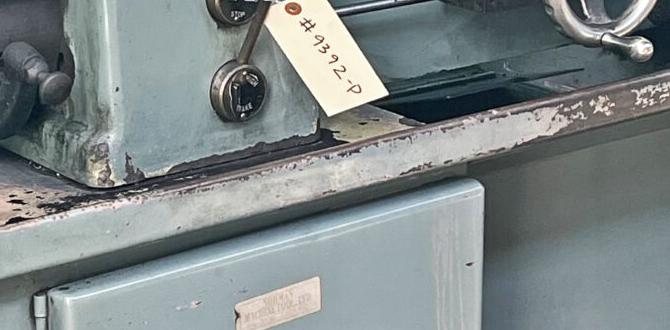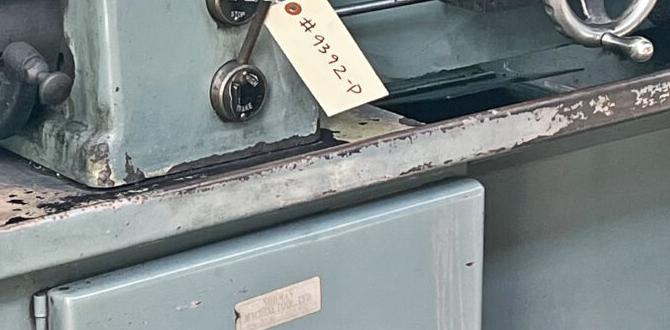Wood lathe vibration often causes frustration, but a simple, essential test can diagnose and fix it. This guide shows you the proven, easy method to ensure smooth, safe, and accurate woodturning, even for beginners. Get your lathe running like new!
Hey there, fellow makers! Daniel Bates here, your guide from Lathe Hub. Ever get that shaky feeling when you start up your wood lathe? That wobbly, buzzing sensation that makes you wonder if your workpiece is about to fly across the shop? You’re definitely not alone. Wood lathe vibration is a super common issue, and it can really mess with your turning, leading to rough finishes, tool chatter, and even safety hazards. It’s frustrating when you’re trying to create something beautiful and all you get is a bumpy ride. But don’t worry, there’s a straightforward, proven method to pinpoint and fix these vibrations. We’re going to walk through it step-by-step, so you can get back to smooth turning and enjoy your woodworking. Stick around, and we’ll get your lathe purring like a kitten in no time!
Why Wood Lathe Vibration Is a Big Deal
It’s easy to dismiss a little wobble as just part of working with wood. However, significant vibration on your wood lathe is more than just an annoyance; it’s a red flag. Think of it like a shaky car wheel – it might still move, but it’s not safe or efficient. For your lathe, excessive vibration can:
Affect your workpiece: Uneven surfaces and tear-out are common results. Your meticulously planned curves might turn into jagged edges.
Damage your tools: Constant jarring can dull your turning tools faster and even damage their cutting edges.
Reduce accuracy: Precise cuts become nearly impossible when the entire machine is shaking.
Increase wear and tear: Over time, vibration can loosen bearings, mountings, and other critical components of your lathe.
Become a safety hazard: This is the most important one. A vibrating lathe is unstable. A workpiece flying off the lathe due to severe vibration can cause serious injury.
Understanding and addressing vibration is fundamental to safe and successful woodturning. It’s an essential skill for anyone who wants to get the most out of their equipment.
The Essential Wood Lathe Vibration Test: A Step-by-Step Guide
Before we dive in, let’s get our basic workshop safety in order. Always wear your safety glasses, and if you’ll be turning, consider a face shield and appropriate hearing protection. Ensure your workspace is clear of clutter.
Here’s the proven method for testing your wood lathe for vibration:
Step 1: The Visual and Auditory Inspection (The Quick Check)
This is your first line of defense. Before you even power up the lathe, give it a good once-over.
Look for obvious issues: Are any parts loose? Check the bed, the headstock, the tailstock, and the tool rest. Give them a gentle wiggle. If anything moves that shouldn’t, tighten it up.
Check the tailstock alignment: Ensure the tailstock is properly seated and locked. A misaligned tailstock is a common cause of vibration.
Listen when you start up: Power on the lathe at its lowest speed. Close your eyes and just listen. Do you hear any grinding, knocking, or unusual noises? Does the sound change as you increase speed?
Observe the machine: Does the entire lathe seem to shake excessively, even at low speeds? Look at the headstock, tailstock, and tool rest.
This initial check can often reveal simple problems like a loose handwheel, an improperly secured tailstock, or debris caught in the drive mechanism.
Step 2: The “No Load” Speed Test
This test helps isolate vibration sources related to the lathe’s internal mechanics rather than the workpiece.
Ensure no workpiece is mounted: Make sure the headstock and tailstock spindles are completely free. No wood, no chuck, nothing.
Start at the lowest speed: Turn on the lathe and let it run at its slowest setting.
Gradually increase speed: Slowly increase the speed, listening and feeling for changes in vibration.
Identify vibration peaks: Pay close attention to speeds where vibration seems to increase noticeably. Note these speeds if possible. Does it get worse, then better, then worse again? This can indicate imbalances in rotating parts.
Check headstock and tailstock spin: While the lathe is running, gently (and very carefully!) place a finger or the eraser end of a pencil near the spinning parts. Can you feel a consistent vibration, or is it more of a smooth spin? Be extremely cautious not to touch any moving parts.
Vibrations felt during this test often point towards issues with the motor, drive belt, pulleys, headstock bearings, or even the spindle itself.
Step 3: The Balance Weight Test (for Manufacturers/Advanced Users)
Some higher-end lathes have balance weights or adjustment screws for the motor or drive system. This step is more applicable if your lathe has such features, often found in more industrial or professional models.
Consult your manual: If your lathe has balance adjustments, refer to your owner’s manual for specific instructions. Upsetting these without proper knowledge can cause more harm than good.
Make small adjustments: If you’re comfortable, and after performing the “no load” test, you might try making very small, incremental adjustments to any balance mechanisms while the lathe is off. Then, re-test.
Observe the effect: Did the adjustment reduce vibration? If so, you’re on the right track.
For most beginner and intermediate users, this step might be skipped or primarily involve ensuring existing balance mechanisms are secure.
Step 4: The Drive Belt Check
The drive belt is a common culprit for vibration, especially if it’s worn, damaged, or improperly tensioned.
Power off and unplug: Always ensure the lathe is completely de-energized before touching the drive belt.
Access the belt: You’ll usually need to remove a cover to access the belt.
Inspect the belt:
Wear and tear: Look for cracks, fraying, missing chunks, or areas that are stretched or distorted. A worn belt can cause uneven rotation.
Tension: The belt should be snug but not overly tight. Too loose, and it can slip and vibrate. Too tight, and it can put excessive strain on bearings. A good rule of thumb is that you should be able to deflect the belt about 1/2 inch with moderate finger pressure midway between the pulleys.
Alignment: Ensure the belt is running true on the pulleys and not wobbling or riding off-center. Mismatched pulleys or a warped belt will cause vibration.
Check pulleys: While you’re there, inspect the pulleys for damage, nicks, or wobbles. Ensure they are securely mounted to their shafts.
A damaged or loose drive belt is surprisingly effective at creating a symphony of shimmies and shakes.
Step 5: The Workpiece Seating and Balance Test
This is where the actual wood comes into play and is often the most significant source of vibration.
Select a piece of wood: Start with a well-squared piece of relatively dense hardwood, like oak or maple. Avoid very green or irregular wood for initial testing.
Mount it securely:
faceplate/Chuck: If using a faceplate or chuck, ensure it’s properly threaded onto the headstock spindle. Tighten it firmly.
Logs/Un-squared Stock: If you’re turning a log or rough lumber, mount it between centers securely. The drive spur in the headstock should be firmly seated in the wood. The tailstock center should be snug against the other end, providing support.
Start VERY SLOWLY: Begin at the absolute lowest speed setting on your lathe.
Observe the wobble: As the piece starts to turn, watch it closely. Is it immediately off-balance and wobbling like crazy?
If there’s severe wobble at low speed: This indicates a major imbalance in the wood itself or how it’s mounted.
Workpiece Imbalance: The wood you’re mounting is likely not balanced. It might have a large knot, a significantly off-center pith, or it might be unevenly shaped.
Mounting Issue: The workpiece might be improperly seated on the drive spur, or the tailstock center might not be bearing properly.
If it spins smoothly at low speed but vibrates at higher speeds: This is more typical.
Introduce a rough shape: With the lathe still at a slow speed, and assuming the initial mounting is stable, use a simple scraping tool or a parting tool to rough out a basic cylindrical shape, removing the corners. Crucially, do this only after the piece has achieved a reasonably round, low-speed rotation.
Gradually increase speed again: As you start to round out the piece, slowly increase the lathe speed. Continue to observe.
Listen for chatter: Chatter is a specific type of vibration that causes a rhythmic buzzing or scraping sound. It’s often caused by a combination of tool sharpness, wood density, turning technique, and lathe stability.
Power off and check: If you notice significant vibration or chatter, power off the lathe and inspect the workpiece. Is it securely mounted? Is it reasonably balanced now that it’s somewhat round?
Troubleshooting Workpiece Imbalance:
Re-mount securely: Ensure the drive spur is biting well into the wood and the tailstock center contact is firm.
Rough-turn one end: Sometimes, turning one end of the workpiece to a rough cylinder can help stabilize it before tackling the other side.
Use a faceplate for unbalanced items: For very unbalanced or eccentric pieces, a robust faceplate and screws can provide better support than a drive spur alone.
Consider the wood properties: Very dense or knotty wood can be more prone to vibration.
This test is vital because the vast majority of vibration experienced by woodturners originates from the workpiece itself or how it’s attached.
Step 6: The Tool Rest and Tooling Check
Your tool rest is your primary support system. If it’s not positioned correctly or is flimsy, it will amplify any vibrations.
Tool Rest Position:
Proximity: The tool rest should be as close to the workpiece as possible without actually touching it. A gap of about 1/8 inch is usually ideal. If the gap is too wide, it allows the tool to jump and vibrate.
Height: The top of the tool rest should typically be slightly below the center line of the workpiece when turning. For roughing, it can be at center, but for finishing, slightly below is often better for most tools. Consult your tool manufacturer or resources like the American Association of Woodturners for specific tool heights.
Tool Rest Stability: Ensure the tool rest locking mechanism is tight. You don’t want it shifting during turning. Many hobbyist lathes have basic post-style rests; these work well if properly locked. More advanced rests offer better rigidity.
Tool Sharpness: A dull tool requires more force to cut, leading to increased vibration and chatter. Ensure your gouges, skews, and scrapers are sharp. A good sharpening system and regular touch-ups are essential. Some suggest a finely honed edge rather than a razor-sharp, but brittle edge for certain turning situations to reduce chatter.
Tool Pressure: Applying too much downward pressure with your tool can also induce vibration. Let the sharp tool do the work.
Tool Selection: Using the right tool for the job helps. For example, trying to hog out large amounts of material with a skew chisel isn’t ideal.
A stable tool rest, sharp tools, and proper technique are crucial for a smooth turning experience.
Step 7: The Tailstock Vibration Test
The tailstock’s job is to support the far end of your workpiece, especially for longer turnings like spindles. If it’s not doing its job, vibration is almost guaranteed.
Ensure tailstock alignment: As mentioned earlier, check that the tailstock is parallel to the headstock bed. A quick misalignment test involves spinning a long, thin piece of dowel or a pencil between centers and seeing if the tailstock end wobbles outwards or inwards relative to the headstock end. An improperly aligned tailstock forces the wood to flex and vibrate. Many lathes have adjustment screws for alignment.
Check tailstock center engagement: The tailstock center should be firmly engaged with the workpiece. If it’s too loose, the workpiece can shift and vibrate. If it’s too tight, it can bind and create its own issues.
Use lubrication: For longer turnings, a little bit of wax or light oil on the tailstock center (not too much, as it can catch wood dust) can help it rotate smoothly with the wood, reducing binding and vibration.
Check tailstock ram: Ensure the tailstock ram moves smoothly. If it’s stiff, it might not be applying consistent pressure.
Step 8: The Lathe Bed and Mounting Test
The foundation of your lathe is its bed and how it’s mounted.
Is the lathe level? Use a spirit level to check if the lathe bed is perfectly level. If not, adjust the feet or shim it as needed. An unlevel lathe can lead to uneven stress and vibration.
Is the lathe bolted down? For larger or more powerful lathes, bolting it to the floor or a sturdy workbench can significantly reduce transmitted vibration. This is especially important if you have a concrete floor.
Check for debris: Ensure there’s no dust, chips, or debris caught between the lathe bed and the stand, or between the bed and the headstock/tailstock.
A solid, level foundation is non-negotiable for minimizing vibration.
Step 9: The Motor and Drive Component Check (Advanced)
If you’ve gone through all the above steps and are still experiencing significant vibration, you might need to look at the motor and internal drive components. This often requires more mechanical knowledge and potentially partial disassembly.
Motor Mounts: Check that the motor itself is securely mounted. Loose motor mounts can transmit significant vibration.
Motor Bearings: If you hear a humming or grinding noise coming directly from the motor, its internal bearings might be failing.
Drive Shaft/Spindle: In rare cases, the main drive shaft or headstock spindle could be bent or damaged, though this is usually due to a significant impact.
Counterweight Check (if applicable): Some lathes have counterweights to balance rotating parts. Ensure these are secure and not loose or damaged.
Resources:
For more in-depth information on lathe mechanics and maintenance, the U.S. Department of Labor’s Occupational Safety and Health Administration (OSHA) provides general machine safeguarding guidelines that can be helpful. While not specific to lathes, the principles of minimizing hazards apply. You can often find valuable diagnostic tips in manufacturer manuals or forums dedicated to your specific lathe model. Learning how to properly maintain and diagnose your machine is an ongoing part of being a skilled craftsperson.
Common Causes of Wood Lathe Vibration Summarized
Let’s break down the most frequent suspects for that shaky lathe blues.
<td style=”padding: 8px
| Cause of Vibration | What to Look For | Typical Symptoms |
|---|---|---|
| Unbalanced Workpiece | Irregularly shaped wood, off-center pith, large knots. | Severe wobble, especially at low speeds; vibration increases dramatically with speed; makes roughing difficult. |
| Improper Workpiece Mounting | Workpiece not seated firmly on drive spur, tailstock center loose or misaligned, chuck not tightened. | Sudden onset of vibration, especially during cuts; workpiece may feel loose. |
| Loose Tool Rest | Tool rest post not locked, rest itself loose. | Chatter, buzzing, inconsistent tool contact, rapid dulling of tools. |
| Dull or Incorrect Tooling | Blunt edges, wrong tool shape for the operation. | Requires excessive force, rough surface finish, burning, audible chatter. |
| Loose Drive Belt or Worn Belt | Belt slipping, cracked, frayed, or excessively loose/tight. | Intermittent vibration, grinding noise, loss of power, inconsistent speed. |
| Incorrect Tailstock Alignment | Tailstock not parallel to headstock spindle axis. | Vibration during turning, especially for longer pieces; wood may flex. |
| Unstable Lathe Base/Mounting | Lathe not level, loose mounting bolts, flimsy stand. |




